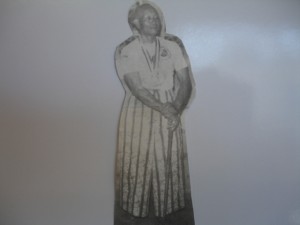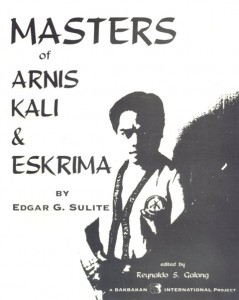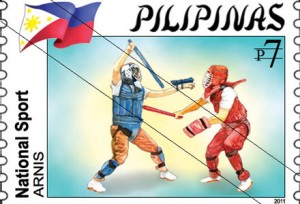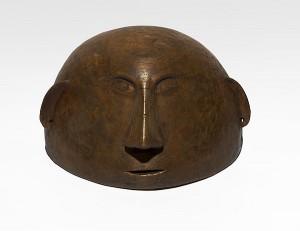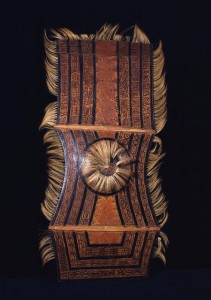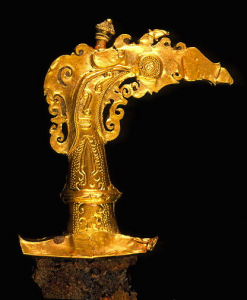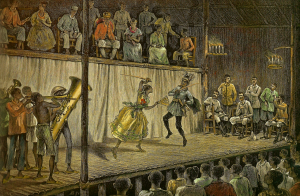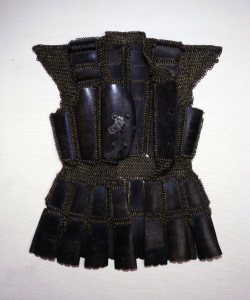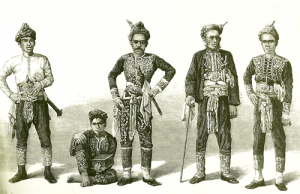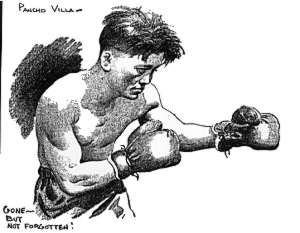
The Origins of Philippines Boxing, 1899-1929 By Joseph R. Svinth Copyright © Joseph R. Svinth 2001. All rights reserved. The assistance of Pat Baptiste, Hank Kaplan, Paul Lou, Eric Madis, Curtis Narimatsu, John Ochs, Michael Machado, and Kevin Smith is gratefully acknowledged. On June 18, 1923, Francisco "Pancho Villa" Guilledo beat Jimmy Wilde to become the world flyweight boxing champion, an accomplishment that was (and remains) a matter of great pride to people of Filipino descent. Unfortunately, while there has been some documentation of the many excellent Filipino boxers who subsequently followed Guilledo to the United States, there has not been as much attention paid to documenting the origins of boxing in the Philippines. This article represents a step toward correcting that omission. People with additional information or corrections are invited to contact the author at jsvinth@ejmas.com. "Pancho Villa, gone but not forgotten." Illustration by Ed Hughes, 1925. Boxing Enters the Philippines US servicemen introduced boxing to the Philippines during the late nineteenth and early twentieth centuries. How this came about is that on April 25, 1898, the United States declared war on Spain, whose colonial holdings included the Philippines. So, on April 27, 1898, Commodore George Dewey ordered his squadron of five cruisers and two gunboats to steam from China to the Philippines, and there, on May 1, 1898, he issued the famous command, "You may fire when ready, Gridley." The resulting US naval victory effectively ended Spanish control of the region, and in August 1898 the US Army began the occupation of Luzon. Then, to the horror of the Filipinos, the Americans did not cede the Philippines to them: instead they decided to keep the islands for themselves. Between 1899 and 1913, this resulted in savage wars of peace whose heroes included Emilio Aguinaldo on one side and Arthur MacArthur, Frederick Funston, Leonard Wood, and John J. Pershing on the other. Casualties in these battles were heavy and one-sided: US casualties were listed as 4,243 killed and 2,818 wounded in action while Filipino casualties are estimated at 16,000 killed, plus another several hundred thousand dead from famine or disease (generally cholera). However, after Theodore Roosevelt’s unilateral declaration of victory in July 1902, US commanders began thinking about how to reduce the rates of desertion, suicide, sexually transmitted diseases, drug abuse, and drunkenness among their soldiers and sailors. Boxing was offered as a potential solution. The reason was that boxers in training were taught to avoid tobacco, alcohol, and sexual activity. Furthermore, explained writer Charles L. Clay in 1887, "Boxing also makes a man self-reliant and resourceful when assailed by sudden or unexpected dangers or difficulties." This, in turn, said a YMCA director named C.H. Jackson in 1909, made young men "Christlike and manly." So, in 1902, Major Elijah Halford (a former secretary to President Benjamin Harrison) asked philanthropists for $200,000 to construct a YMCA in Manila, and by 1904, Army officers such as Edmund Butts were extolling the virtues of boxing in tropical environments such as Hawaii, Puerto Rico, and the Philippines. US Military Boxers On November 18, 1899, soldiers of the 11th US Cavalry reported finding a pair of boxing gloves made by Sol Levinson of San Francisco abandoned in the Luzon village of San Mateo. According to Damon Runyon, writing in October 1925, Filipino prisoners reported that the "gloves had been brought in by a renegade soldier from the negro Twenty-fourth Infantry, and that he had been schooling the Filipinos in their use." Many early boxers in the Philippines were African American, as the all-black 9th and 10th US Cavalry, 24th and 25th US Infantry, and 48th and 49th US Volunteer Infantry formed a significant percentage of the American soldiers serving in the Philippines between 1899 and 1902. Following Roosevelt’s declaration of peace, most of the black troops were sent back to the United States but in 1913, the 25th was in Hawaii. There the Honolulu Advertiser noted: The Twenty-fifth is proud of its colored ringmasters and particularly of Hollie Giles, a welterweight of 155 pounds, who is described by the men as a ‘whirlwind’ fighter; Morgan, a heavyweight at 190 pounds; Carson, a light heavyweight, and Ananias Harris, a light heavyweight. Meanwhile, from 1913 until 1917, the 24th was in the Philippines, serving at Camp McGrath (Batangas) and Fort Mills (Corregidor). Noted African American fighters from this period included the middleweights Joe Blackburn, "Craps" Johnson, and "Demon" White. Of course, there were also white soldiers who boxed in the Philippines. The most famous was New Jersey’s Mike Ballerino. "Ballerino had a chip on his shoulder," Pancho Villa recalled in early 1925. "He dared any of the Filipinos to knock it off." So Pancho Villa did, fighting … [Read more...]
